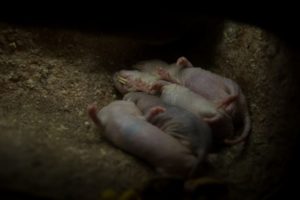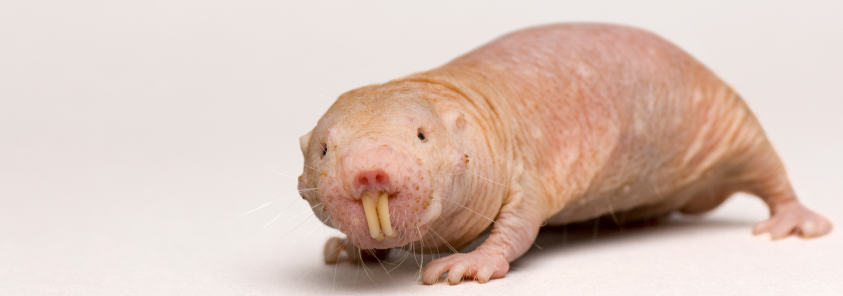by Buck Institute
February 28, 2020 . BLOG
Naked Mole-Rats: Live Slow, Die Old
 By Garbo Gan, Former Lab Technician in Kennedy Lab
By Garbo Gan, Former Lab Technician in Kennedy Lab
If its nude and wrinkled appearance causes you to take a closer look at this eccentric animal, then its remarkable biology may blow you away. Native to East Africa, naked mole-rats occupy complex underground tunnel systems in colonies of up to 300 individuals. Despite their name, naked mole-rats are neither moles nor rats, and are more closely related to porcupines than to mice. Naked mole-rats have a very low metabolic rate, most likely due to the lower oxygen availability of the underground tunnels that they have evolved to live in. Not only are they able to survive nearly 20 minutes without oxygen; they are also unable to feel certain types of pain, are resistant to aging-associated diseases like cancer, and are extremely long-lived for their body size, with individuals reaching 30 years of age or more.
The naked mole-rat’s biology has garnered interest from aging researchers since the pioneering work of Dr. Rochelle Buffenstein’s lab that established the animal as a unique model organism for exploring mechanisms of longevity and health.* Some studies have pointed to their pulsed rhythm of oxidative stress--a consequence of being able to increase and decrease their metabolic rate in response to resource plenitude or scarcity, respectively--and improved DNA repair as likely explanations of their increased lifespan. Some scientists have also postulated that the increased high molecular weight hyaluronic acid production, a compound that improves skin elasticity, underlies the mole-rat’s resistance to cancer.

In the deserts and grasslands of East Africa, naked mole-rats can be found in underground burrow systems that maintain a relatively constant 86 degrees Fahrenheit, despite the daily fluctuations in temperature above.

Naked mole-rats sleep together in a burrow chamber.
Why does the naked mole-rat, of all creatures to inhabit the planet, possess features such as decreased metabolic rates and greater skin elasticity? The answer may be found, in part, by examining the unique set of challenges naked mole-rats have evolved to handle in day-to-day survival. For example,while underground tunnels stay at a relatively constant temperature of 86 degrees Fahrenheit, the deserts of East Africa are often dry. Imagine having to dig and plow through stretches of hard soil to search for sparse offerings of underground tubers, all while having to breathe air with lower amounts of oxygen! (Naked mole-rats are able to get all the water they need from the roots that they eat.) Lower metabolic rates allow mole-rats to conserve energy for only the most vital of functions. It certainly helps to have reduced pain sensitivity, in addition to elastic skin, when moving through the abrasive terrain.
So it may be that extreme living conditions have created selective pressure on naked mole-rats to rely on special adaptations, but what is the connection to their long lifespan? Through an international collaboration, some scientists have attempted to address this question by looking at the rate of brain development in naked mole-rats versus mice. Normally, mice live for up to 3 years, while mole-rats can reach 30 years. The same stages of neuronal growth and maturation that took place in the brains of juvenile and young adult mice were found to occur over a longer stretch of time in naked mole-rats, lasting as long as 10 years. In addition, throughout this period of slowed neuronal maturation, naked mole-rat brains were found to retain structural plasticity, an important function for the maintenance of memory and cognition that declines with age.
These findings, while dealing only with brain development, are consistent with the hypothesis that the naked mole-rat displays neoteny (the characteristic of protracted development and retaining juvenile traits into adulthood); or, in other words, a slowing down of the biological clock of maturation. Neoteny can be observed in the various species of salamanders like the long-lived axolotl, and also in humans and domesticated animals. In axolotls, food scarcity forces the young to persist in juvenile aquatic forms instead of growing into the adult terrestrial forms, which have higher energetic requirements. In a similar vein, the pressures of the environment (i.e. low oxygen, aridity, heat, scarce food supply) may have allowed naked mole-rats to evolve toward trends of decreased rates of energy expenditure and slow-motion development. Thus, the naked mole-rat’s longevity may simply be a natural side effect of neoteny.
In the wild, naked mole-rats sometimes use tools to help with the excavation of burrows. They value hygiene in their home and maintain designated chambers for urination and defecation. Like other mammals, young mole-rats will sometimes engage in rough-and-tumble play. Naked mole-rats also participate in farming as stewards of sustainability of their major food source, the plant Pyrenacantha kaurbassana: they will cover up the eaten parts of the tuber with soil so that the plant may regenerate. Intelligent behavior is also observable in the species.
As seen from these studies, the naked mole-rat’s longevity and resistance to a variety of aging-related diseases can teach us a lot about the mechanisms of aging and disease. Scientists are hopeful that new treatments can be uncovered the more we learn about how long-lived animals acquire their longevity. Although the interest in naked mole-rats originated from being discovered as the first mammal species to demonstrate eusociality (the highest-ranked organization of social behavior, similar to bees and ants), the naked mole-rat’s popularity with aging researchers is increasing. Unlike mice, worms, or yeast, which are common model organisms in research on aging, naked mole-rats have a significantly longer life cycle, which means that they require greater time and financial investment to be studied in captivity. Regardless, interest in these creatures will continue while we search for more answers about their remarkable biology. The naked mole-rat is a champion of endless fascination for aging researchers, ecologists, and curious citizens alike.
*None of the research findings mentioned in this article should be construed as medical advice.

SHARE